Introduction
- Books Name
- CBSE Class 6 Science Book
- Publication
- Param Publication
- Course
- CBSE Class 6
- Subject
- Science
INTRODUCTION
Magnetism has been a source of curiosity for ages. Magnets are commonly found in science laboratories, toys and in the magnetic stickers that we stick to refrigerators and steel almirahs. The earth itself acts as a magnet.
Magnet
A mineral was discovered in the town of magnesia which was found to have a wondrous property. It could attract pieces of iron towards it. This mineral is called magnetite. Further it was found that thin strips of magnetite always align themselves in a particular direction when suspended freely in air. It was found that magnetite is mainly composed of oxides of iron (Fe3O4). Magnetite (Fe3O4) is the world’s first magnet.
A substance which attracts small pieces of iron, nickel, cobalt and steel and points in North-South direction when freely suspended (or hanged freely) is known as a magnet.
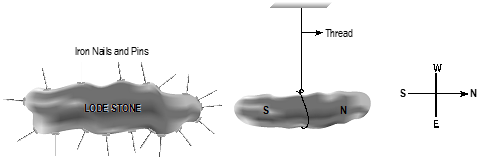
Types of Magnet
(i) Natural magnet : A magnet which occurs naturally and is not made by any artificial means is called a natural magnet. Natural magnets are irregular in shape, moreover they are weak magnets. The natural magnet made from magnetite, which is an ore of iron [Fe3O4].
(ii) Artificial magnet : A substance to which properties of the natural magnet are imparted by artificial means is called artificial magnet. The artificial magnets made from iron, steel, cobalt and nickel.
Example : An iron bar can be made a magnet by rubbing it with a natural magnet. Such a magnet is known as Man made or artificial magnet.
Artificial magnets are of different shapes. A bar magnet (i.e. rectangular in shape) and U-shaped magnet are common example of artificial magnets.
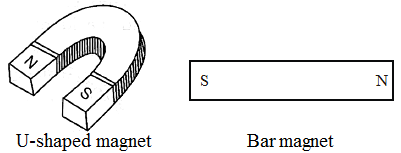
Important Properties of Magnets
Property of attraction : Magnets attract small pieces of materials like iron, nickel, and cobalt. The property of a magnet to attract small pieces of iron seems to be concentrated in small regions at the ends of the magnet. These regions are called magnetic poles. The pole which points towards geographic north is called North pole of the magnet. The pole which points towards geographic south is called South pole of the magnet.
Property of direction : A freely suspended magnet always aligns itself in the North-South direction.
Like-poles of magnets repel each other and unlike-poles attract each other, just as like-charges repel and unlike-charges attract. Since a magnet can attract small pieces of iron and also the opposite pole of another magnet, property of attraction is not a sure test to find whether a given piece is a magnet or not. Repulsion is a sure test to confirm whether a given piece is a magnet or not.
Property of induction : A magnet can induce magnetism in substances like soft iron, cobalt, nickel etc.
Breaking a magnet successively into smaller pieces would still produce tiny magnets each with a north pole and south pole. The above phenomena is observed till we reach molecular stage.
Magnetic poles always exist in opposite pairs. Single magnetic poles never exist.
Temporary and Permanent Magnets
(a) Temporary Magnets : The magnets which cannot retain their magnetism for a long time are called temporary magnets. The temporary magnets are made from the soft iron.
Exmple : Electromagnet.
(b) Permanent Magnets : The magnets which retain their magnetism for a very long time are called permanent magnets. The permanent magnets are generally made from steel. More powerful permanent magnets are made from Alnico, an alloy of aluminium, nickel and cobalt or from ferrite. The ferrite made permanent magnets are quite strong.
Magnetic and non-magnetic materials
- Books Name
- CBSE Class 6 Science Book
- Publication
- Param Publication
- Course
- CBSE Class 6
- Subject
- Science
Types of substances
(a) Magnetic Substances : Those substances that are attracted by magnets are called magnetic substances.
Example : Iron, cobalt, nickel, steel etc.
(b) Non-Magnetic Substances : Those substances that are not attracted by magnets are called non-magnetic substances.
Example : Plastic, rubber, glass etc.
Making a Magnet
The methods by which an ordinary piece of any mangetic material, like iron or steel, can be made a magnet are single touch method, double touch method and electrical method. Let us study each method separately.
(a) Single touch method : A piece of any magnetic material, like iron or steel (a nail, knitting needle, bolt, etc.), is taken and placed on a bench or a tale. A bar magnet is brought close to the magnetic material (say an iron piece AB). One end of the bar magnet is stroked against it, moving from end A to end B of the iron piece.
When the bar magnet reaches end B, it is lifted and the stroke repeated from end A to end B, it is lifted and the stroke repeated from end A to B.This procedure is repeated several times, keeping two things in mind.
(i) The same pole of the bar magnet should be used every time
(ii) Strokes should be in the same direction.
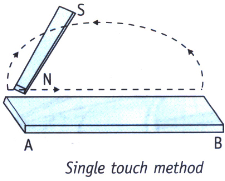
By Stroking the iron piece with the north pole of the bar magnet, end A becomes the north pole and end B the south pole.
(b) Double Touch Method : The iron piece to be mangetized, say AB, is placed on a bench and two bar magnets of equal strengths are taken. Here, the opposite poles of both the magnets are stroked, at the same time, from the centre to the opposite ends of the iron piece being magnetized. This step is repeated may times.
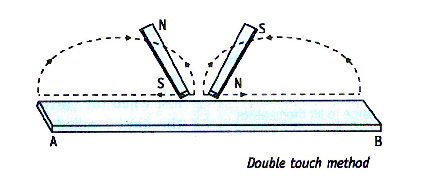
Then,the end A of the iron piece becomes the north pole and end B becomes the south pole.
(c) Electrical Method : Hans Christian Oersted, a Danish scientist, discovered in 1819 that a wire carrying electric current behaves like a magnet. This discovery provided the best method to make mangets by using an electric current.
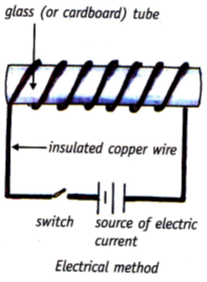
A long, insulated copper wire is taken. About 300 or more turns of the wire are wound around a glass or cardboard tube. The turns of the wire are kept as close together as possible. The ends of the wire are connected to a source of electric current and a switch. A knitting needle is put inside the tube and the current switched on for a short period of time. When the needle is removed from the tube, it behaves like a magnet.
Poles of magnet
- Books Name
- CBSE Class 6 Science Book
- Publication
- Param Publication
- Course
- CBSE Class 6
- Subject
- Science
Electromagnet
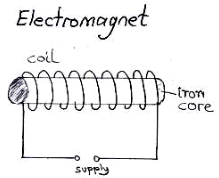
When the current carrying coil is brought near a suspended bar magnet one side of the coil repels the north pole of the magnet. The otherside of the coil attract the north pole of the magnet. Thus, a current carrying coil has both north and a south pole like a magnet. Such a magnet is called electromagnet.
Factors which effect the strength of electromagnet :
(A) magnetic effect of current depends on number of turns.
(B) magnetic effect of current depends the value of current.
(C) magnetic effect of current depends on the nature of core inside the coil.
Uses of electromagnets
(i) They are used to lift heavy iron pieces. They are fitted on cranes lifting heavy objects of scrap iron.
(ii) They are used in many devices like electric bell, electric horn, telephone receiver, electric relay, microphones, radio set, television, loudspeakers etc.
(iii) The electromagnets are also used to separate magnetic material from the junk.
(iv) Doctors use tiny electromagnets to take out small pieces of magnetic material that have fallen in the eye.
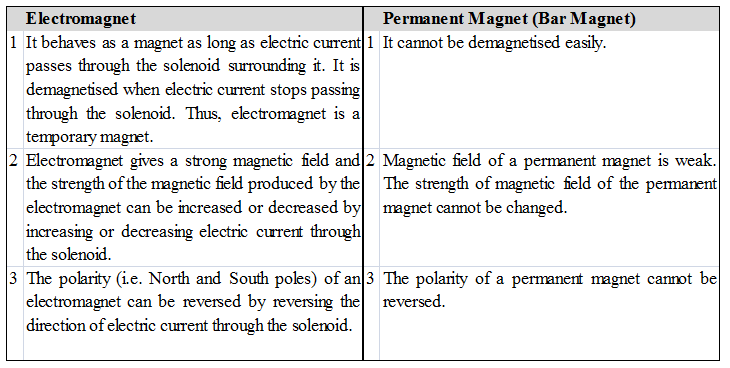
Finding directions
- Books Name
- CBSE Class 6 Science Book
- Publication
- Param Publication
- Course
- CBSE Class 6
- Subject
- Science
The magnetic campass
When people think of instruments that help with direction finding, the first one that strikes to mind is probably the magnetic compass. It is the oldest instrument for navigation and has been a vital tool for navigators at sea for centuries. The compass allows ships to steer a selected course. By taking bearings of visible objects with a compass, the navigator is also able to fix a ship’s position on a chart.
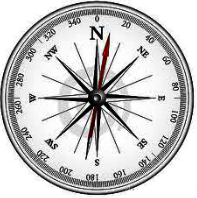
First time, it used by chinese people. The Chinese were probably aware that an iron bar stroked with a lodestone acquired a directional north-south property as long as 2000 years ago. However, the precise date at which this knowledge was used to create the first magnetic compass is unknown. By the 10th century, the idea had been brought to Europe, probably from China, by Arab traders. Magnetic compasses of a very simple kind were certainly in use in the Mediterranean as early as the 12th century. However, early compasses were not very reliable. Although the magnetic compass was in general use in the Middle Ages, little was known about precisely how it worked.
A compass is an extremely simple device. A magnetic compass (as opposed to a gyroscopic compass) consists of a small, lightweight magnet balanced on a nearly frictionless pivot point. The magnet is generally called a needle. One end of the needle is often marked “N,” for north, or coloured in some way to indicate that it points toward north. On the surface, that’s all there is to a compass.
Make your own magnet
- Books Name
- CBSE Class 6 Science Book
- Publication
- Param Publication
- Course
- CBSE Class 6
- Subject
- Science
Methods of Demagnetising a Permanent Magnet
(i) Magnet can be demagnetised by :
(A) If the magnet is stored without using magnetic keepers, Self-demagnetisation will be possible.
Magnets tend to become weak after some time. This weakening is called self-demagnetisation. Small pieces of soft iron are placed in contact with their opposite poles. These pieces of soft iron are called magnetic keepers.
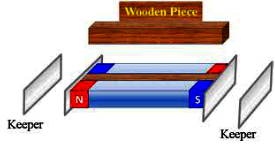
(B) Dropping it from a height or by rough handling.
(C) Heating or hammering the magnet.
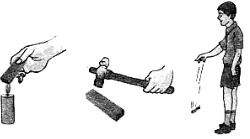
Magnets lose their property on heating hammering and dropping
Extended Learning – Activities and Projects
1. Phenomenon of attraction property of magnet
Spread out some iron fillings over a sheet of paper. Now, move a bar magnet in the fillings taking care that all parts of the magnet moves through iron fillings and observe how the iron fillings are distributed all over the magnet.
We will notice that most of the iron fillings cling near the ends of the magnet while there are a few iron fillings near the middle.
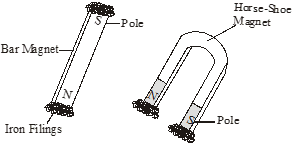
Repeat the experiment with a horseshoe magnet. This experiment explains the attractive property of magnets.
2. Magnetise an iron needle using a bar magnet.
Insert the magnetised needle through a small piece of cork or foam. Let the cork float in water in a bowl or a tub. Make sure that the needle does not touch the water. Your compass is now ready to work. Make a note of the direction in which the needle points when the cork is floating. Rotate the cork with the needle fixed in it, in different directions. Note the direction in which the needle points when the cork begins to float again without rotating. Does the needle always point in the same direction, when the cork stops rotating?
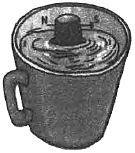
Yes, the needle always points towards the north when the cork stops rotating.
3. Phenomenon of attraction and repulsion property of magnet.
Bhawana witnessed on interesting game at the fair. A duck was floating in a tub. When a plate containing some grains of rice was brought close to the duck, the duck moved towards the plate. But, when a plate containing some pebbles was brought close to the duck, it moved away from the plate. Explain how this could have been possible.
This game is based on the plate containing rice may have magnet attached to its bottom. The magnet is fitted in such a way that its north-pole points towards rice grains, while south-pole indicate towards pebbles. A magnet (bar magnet) may also be fitted in the bottom of the duck, where south-pole points towards mouth and north-pole towards tail of the duck.
When the rice portion of the plate is brought closer to the duck, the duck moves towards rice grains because unlike poles of two magnets attract each other. In second situation, same (like) poles repel each other. So the duck moves away.
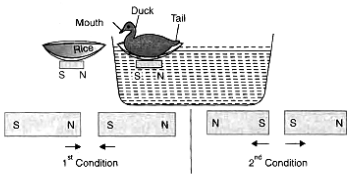
Attraction and repulsion between magnets
- Books Name
- CBSE Class 6 Science Book
- Publication
- Param Publication
- Course
- CBSE Class 6
- Subject
- Science
Let Us Recapitulate
1. Natural magnet: Magnetite is called natural magnet.
2. Uses of a magnet: A magnet finds its use at a number of places. For example, refrigerator's door, some pencil boxes, many toys, magnetic stickers, soap stand, pin stand, all make use of a magnet for their functioning.
3. Shapes of magnets: Magnets are made of different materials and in different shapes.
4. Effect of a magnet on materials: A magnet attracts certain materials, whereas some do not get
attracted towards magnet.
5. Magnetic materials: The materials which get attracted towards the magnet are known as magnetic materials, e.g., iron, nickel, cobalt.
6. Non-magnetic materials: The materials which are not attracted towards the magnet are known as non-magnetic materials, e.g., leather, plastic, cloth, paper.
7. Magnetic poles: Magnetic attraction is maximum near the ends of the magnet. These ends are called magnetic poles.
8. When suspended freely, magnet always aligns in north-south (N-S) direction.
9. Lode stone: It was a stone used by sailors in olden days to identify directions when they were in sea.
10. Compass: This is a small glass case containing a magnetised needle pivoted on a nail. The needle can rotate freely. Wherever it is kept, its needle always rests in north-south direction. Normally the
north-pole of the needle is painted red or some other indication is given to identify north and south-poles. So using this needle, north and south can be identified.
11. Attraction between two poles: Opposite poles of two magnets attract each other. It is called
attraction.
12. Repulsion between two poles: Similar poles of two magnets repel each other. It is called repulsion.
13.Magnetic effect can pass through screen: Magnetic influence can pass through screens of some substances like cloth, plastic, paper, glass, etc.
14. Magnets lose their properties if they are heated, hammered or dropped strongly and hardly.
15. To keep them safe, bar magnets should be kept in pairs with their unlike poles on the same side. They must be separated by a piece of wood while two pieces of soft iron should be placed across their ends. For horse-shoe magnet, one should keep a piece of iron across the poles.
16. Soft iron is used to make electromagnets.
Key Words
1. Compass: This is a small glass case containing a magnetised needle pivoted on a nail. The needle can rotate freely and always rest in north-south direction.
2. Magnet: A magnet is a metallic object which attracts iron or magnetic things.
3. Magnetite: It is an ore of iron which has magnetic properties.
4. North pole: When suspended freely, one pole of the magnet always points towards north. This is known as north-pole.
5. South pole: When suspended freely, the end of a magnet which points towards south. This is known as south-pole.

 Param Publication
Param Publication
 PathSet Publications
PathSet Publications
